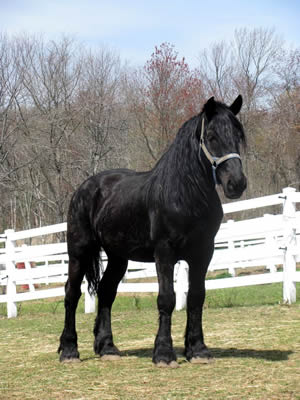History
Edward Harris of Moorestown, New Jersey first imported Percherons to the United States in 1839. Although in his two attempts to import eight Percheron horses to America, only two survived the journey, a mare named Joan and a stallion called Dilligence. These two horses helped establish the Percheron breed in America. Diligence reportedly sired over 400 foals with three of his being recorded among the foundation stock in the first American Percheron stud book in 1876.
No other Percheron importations were recorded until 1851. The stallions, Normandy, Gray Bill and Louis Napoleon, were imported in that year. Louis Napoleon had a profound effect on the Percheron breed in America and is owners were instrumental in the forming of the Percheron Association in 1876.
Thousands of Percherons were imported to Americans in the last half of the 19th century, and importations continued up until World War II. The Percheron quickly became the favorite of both the American farmer and the teamster who would move freight on the nation's city streets.
The Percheron was so popular that by 1930, the government census showed that they were three times as many registered Percherons as the other four draft breeds combined. Following World War II, the invention of the modern farm tractor made the breed nearly extinct. As America modernized and mechanized, the Percheron was all but forgotten. However, a handful of farmers including many Amish, dedicated to the preservation of the breed, kept it alive through the next twenty years of the draft horse depression which lasted through the 1950s and 1960s.
The late 1960s saw a renaissance in the draft horse business as Americans rediscovered the usefulness of the draft horse. Today, Percherons are back on small farms and working in the fields and thousands of are used for recreation such as hayrides, sleigh rides and parades.
Percherons are shown in competition hitching, halter and riding classes at many state and local fairs across the country. They are also used in advertising and the promotion of other businesses. The Percheron is also a common sight on many city streets as the carriage business flourishes.
Behavior
The Percheron has a very pleasing disposition. He is proud, alert, intelligent and a willing worker.
Function
The Percheron is the most famous and populous of all French draft breeds in the world today. They were used to improve both the Ardennes and Vladimir Heavy Draft horses, and to create the Spanish-Norman breed, a cross between the Andalusian and the Percheron. By the end of the 19th century, Percherons made up the majority of driving horses in Paris. The Percheron is still used extensively for draft work and, like other draft breeds, it is also used in France for meat production. Around the world, Percherons are used for parades, sleigh rides and hayrides, as well as being used to pull carriages in large cities. The largest team of working Percherons in Europe is found at Disneyland Paris, where the breed makes up 30 percent of the horses in the park and the horses work to pull trams on the main park street. One of the most famous horse teams in the United States is the Heinz hitch of Percherons, having appeared multiple times at the Tournament of Roses Parade.
In Great Britain, the Percheron is used for advertising and publicity, as well as forestry and farm work. They are crossbred with lighter horses by breeders of heavy hunters in order to increase size and improve disposition. Purebred Percherons are also ridden, and some have proven useful at show jumping. Crossbred Percherons have been used successfully in dressage. In both the Falkland Islands and northern Australia, Percherons have been crossed with local mares, primarily Criollos in the Falklands, to produce larger stock horses with greater stamina. These crossbred horses are used extensively in both the sub-Antarctic climate of the Falklands and the sub-tropical climate of Australia for working stock. In Australia they are also crossed with Thoroughbreds for use as mounted police horses.
In 1978, the first World Percheron Congress was held in Great Britain, and has been held annually ever since. Although the majority of the shows have been held in North America, four – in 1980, 1989, 2001 and 2011 – have been held in France. Each year, in July, the French national breed show is held in Haras du Pin.
Health
No breed specific issues were found.






